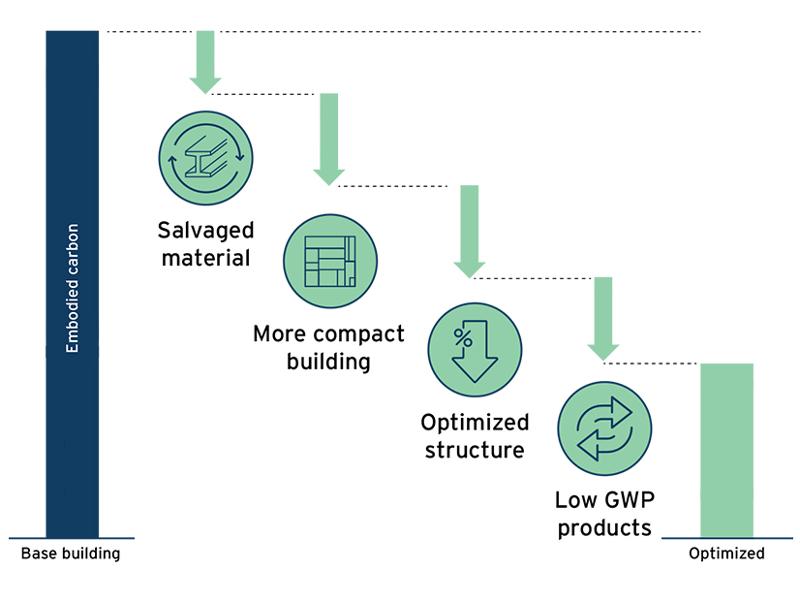The building sector has the potential to transition from being a significant source of emissions to becoming a crucial part of the solution for climate change. A recent report highlights the possibility of new buildings acting as carbon sinks, effectively drawing down carbon from the atmosphere. By implementing sustainable construction practices and reducing embodied carbon in structures, the building sector can play a vital role in mitigating climate change. Let's explore the study's findings and how they can pave the way for a greener future.
Understanding the Potential of New Buildings
Discover how new buildings can become a solution for climate change and play a vital role in reducing carbon emissions.
New buildings have the potential to act as carbon sinks, effectively removing carbon dioxide from the atmosphere. By implementing sustainable construction practices, such as using low-carbon materials and energy-efficient designs, these buildings can significantly reduce their carbon footprint.
Studies have shown that the building sector contributes to a significant portion of global greenhouse gas emissions. However, with advancements in technology and a shift towards sustainable building practices, the sector can transform from being a major emitter to a crucial part of the solution for climate change.
Reducing Embodied Carbon in Structures
Explore the concept of embodied carbon and learn how builders can minimize it in the construction process.
Embodied carbon refers to the carbon emissions associated with the entire life cycle of a building, including the extraction of raw materials, manufacturing, transportation, construction, and disposal. Minimizing embodied carbon is essential for creating sustainable buildings.
Builders can reduce embodied carbon by using materials with a lower carbon footprint, such as recycled or locally sourced materials. Additionally, adopting innovative construction techniques, such as modular construction or using renewable energy during the construction process, can further reduce carbon emissions.
The Role of Sustainable Design in Carbon Drawdown
Discover how sustainable design practices can contribute to carbon drawdown in new buildings.
Sustainable design practices focus on maximizing energy efficiency, minimizing waste, and reducing the overall environmental impact of a building. By incorporating features such as passive heating and cooling systems, green roofs, and solar panels, new buildings can generate renewable energy and reduce their reliance on fossil fuels.
Furthermore, sustainable design emphasizes the use of natural and non-toxic materials, which not only reduces the carbon footprint but also promotes a healthier indoor environment for occupants. By integrating these sustainable design principles, new buildings can actively contribute to carbon drawdown and create a more sustainable future.
Benefits of Carbon-Neutral Buildings
Explore the advantages of carbon-neutral buildings and how they can contribute to a more sustainable future.
Carbon-neutral buildings are designed to have zero net carbon emissions over their operational lifetime. These buildings utilize renewable energy sources, such as solar or wind power, to offset their carbon footprint. By achieving carbon neutrality, buildings can significantly reduce their environmental impact and help combat climate change.
Additionally, carbon-neutral buildings often result in lower energy costs for occupants, as they rely on clean and renewable energy sources. Furthermore, these buildings can serve as showcases for sustainable design and inspire others to adopt similar practices.
Conclusion
New buildings have the potential to be more than just structures; they can be part of the solution for climate change. By implementing sustainable construction practices and reducing embodied carbon, these buildings can act as carbon sinks and help draw down carbon from the atmosphere. The building sector has the opportunity to transition from being a major contributor to greenhouse gas emissions to becoming a key player in mitigating climate change. Embracing sustainable design and construction techniques can pave the way for a greener and more sustainable future.
FQA :
What is embodied carbon?
Embodied carbon refers to the carbon emissions associated with the entire life cycle of a building, including the extraction of raw materials, manufacturing, transportation, construction, and disposal.
How can builders reduce embodied carbon in structures?
Builders can reduce embodied carbon by using materials with a lower carbon footprint, such as recycled or locally sourced materials. Additionally, adopting innovative construction techniques, such as modular construction or using renewable energy during the construction process, can further reduce carbon emissions.
What are the benefits of carbon-neutral buildings?
Carbon-neutral buildings have zero net carbon emissions over their operational lifetime. They rely on renewable energy sources to offset their carbon footprint and contribute to combating climate change. Additionally, carbon-neutral buildings often result in lower energy costs for occupants and serve as examples of sustainable design.

